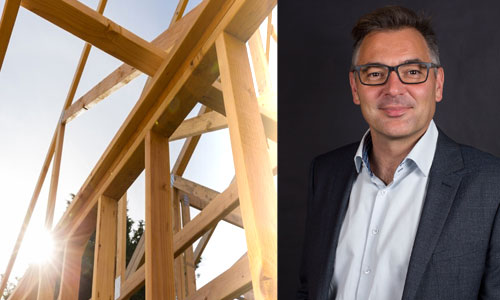Biophilia, Brexit and Buildings
Opinion Piece by David Hopkins, CEO, Timber Trade Federation
The pandemic has certainly put us back in touch with nature: there’s less pollution, we’re able to hear birds sing, and there’s a growing appreciation of the importance of biodiversity in our surroundings. The Biophilia movement in construction is also happily gaining ground. Greater use of wood in office, hospital and commercial interiors promotes feelings of wellbeing, but also generates practical business benefits such as productivity.
Wood in buildings, whether interior or exterior, locks away CO2 at the rate of a tonne of CO2 per cubic metre of wood, and life cycle analysis work confirms that the majority of wood products – from CLT (sometimes also referred to as ‘mass timber’) through to wood windows – are carbon negative, due to the low-energy requirement for manufacturing coupled with constant replanting and long-term management of forests in Europe.
Over 90% of wood used in housing in the UK comes from sustainable forests in EU countries, largely from Scandinavia, the Baltics, Austria and to a much lesser extent countries like France and Germany. Britain’s forests, whilst able to supply a proportion of the carcassing, fencing and decking demands of UK construction, cannot in any way replace the level of supply from countries within the EU. Our enduring and interlocked construction sector relationship with timber from Europe will be tested by Brexit negotiations, and in particular by the customs arrangements which will replace almost half a century of working with our near timber-supplying neighbours across the Channel and the North Sea.
The government’s new Customs Academy recognises that, come what may at the end of the Brexit Transition Period, some 200 million new customs documents will be needed to keep imports flowing into the UK. Traders (including importing timber traders) are expected to switch over to HMRC’s new Customs Declaration System (CDS) by September this year, and this will run in tandem with the existing customs system until March 2021. At the time of writing, no-one currently knows when any trade agreement will be finalised, and what further influence this may have on customs checks and systems. Looking ahead, all of us across the construction supply chain will need to plan somewhat further in advance than we’ve been used to, if we wish to continue maximising the climate change benefits of using more wood in construction.
Further challenges to reaping the full climate change benefits of building new housing using timber come from the Government’s consultation reviewing its ban on the use of combustible materials in, and on, the external walls of buildings. The TTF led the Confederation of Timber Industries’ response to the consultation, and worked with interested parties across architecture, building specification and construction to support a science-based approach to regulations around fire safety compliance, and on the specification and installation of combustible products such as CLT and cladding in/on buildings of up to 11 metres in height.
We applaud the Government’s aim of creating safer buildings. Yet we do feel that there is a perception gap somewhere. The consultation was often referred to as a ‘ban on cladding’, yet has also extended to the structural walls of buildings. This has implications not only for bigger projects using CLT at large scale, but also for all those, including our colleagues in the builders’ merchant sector, selling structural and framing timbers.
The government seems to be treating cladding and structural timbers in the same way. Our suggestion is that the Scottish Government’s approach, of separately regulating the two aspects, is the right one. Timber-frame building is an established method used in 83% of new builds in Scotland. The Scottish Government’s view, that timber cladding can be used up to a height of 11 metres, also provides clarity.
When specified and installed correctly, timber cladding is a safe, sustainable, popular and practical solution for many building types. We fully recognise that high rise buildings need additional safety measures and we support the use of only non-combustible cladding in categories A or A1 above 11 metres. Yet height is not the only issue affecting safety and regulators should look beyond this.
The best way that Government could achieve a safer building system is by introducing mandatory, comprehensive fire-risk assessments during the design process for buildings such as high-rises, community and assembly buildings and schools. An independent, professional fire risk assessment that considers building design, use, materials and location, is essential at the design stage for multi-occupancy and assembly buildings, regardless of height. We also advocate a locking-down of the specification between the design and construction phases of a building to ensure that the use of materials, the scope of work, installation, and other aspects of designing for fire are not diluted or lost during the project.
We firmly stand behind comprehensive fire risk assessments and very much support stronger enforcement in the form of a new Building Safety Regulator. The principle of risk assessment has been embodied in the Construction Design and Management Regulations for some years but this needs rigorous enforcement. With architects, including their professional body RIBA, campaigning in support of ‘Safe Structural Timber’, alongside engineers and climate-aware major contractors, the sector awaits the government’s response with interest.
Source: FutureBuild






Leave a Reply
Want to join the discussion?Feel free to contribute!